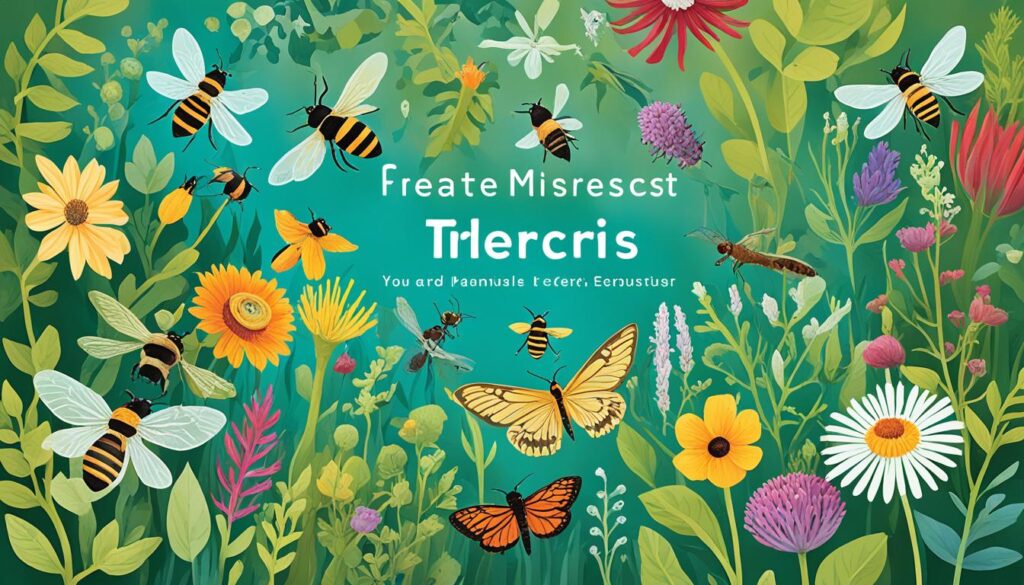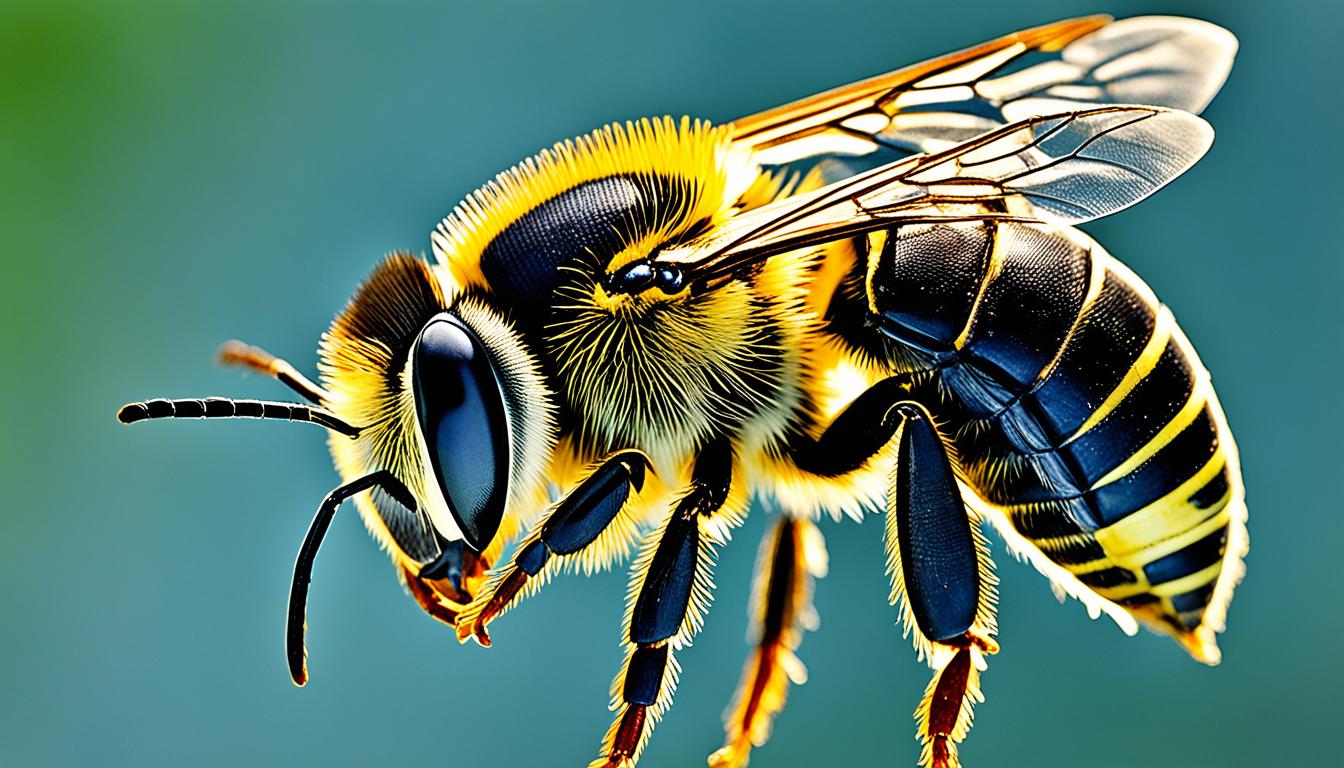A staggering 80% of the world’s flowering plants and 75% of global food crops depend on the vital role of bees in pollination. Yet, for decades, scientists have grappled with an age-old mystery surrounding these fascinating creatures. Now, a recently discovered bee species has emerged as the unexpected key to unlocking this enigma.
This groundbreaking discovery has generated a buzz in the scientific community, providing crucial insights that have long eluded researchers. By delving into the secrets of this newfound bee species, scientists have gained valuable knowledge about their behavior, genetics, and ecological significance.
Key Takeaways:
- A newly discovered bee species has offered valuable insights to solve a long-standing mystery in the scientific community.
- 80% of the world’s flowering plants and 75% of global food crops rely on bees for pollination.
- This newfound bee species has become a focal point for extensive research, shedding light on their behavior and ecological role.
- Genetic analysis of this species has provided crucial clues to unravel the age-old mystery.
- The newfound knowledge has profound implications for conservation efforts and future studies on bees.
The Discovery of the Newfound Bee Species.
The discovery of the newfound bee species has emerged as a remarkable breakthrough in the field of entomology. During a research expedition in a previously unexplored region, scientists serendipitously encountered this extraordinary species, provoking a wave of excitement within the scientific community. Through meticulous genetic analysis and comprehensive behavioral studies, researchers have unequivocally determined that this bee species is distinct from any known species. Laden with unique characteristics, this newfound species has provided scientists with invaluable clues to unravel the age-old mystery that has long eluded them.
With the discovery of this newfound bee species, scientists have reached a significant milestone in their quest for knowledge about these fascinating creatures. This breakthrough not only showcases the infinite wonders of nature but also highlights the vastness of unexplored territories where fascinating species await discovery.
The journey to the discovery of this extraordinary species began during an expedition aimed at exploring uncharted ecological landscapes. Guided by their passion for unraveling nature’s mysteries, a team of intrepid researchers embarked on an adventure into the heart of the unknown. Little did they know that their expedition would lead them to the doorstep of this newfound bee species, poised to transform the scientific understanding of these remarkable insects.
The discovery of this newfound bee species marks a pivotal moment in the annals of entomological research. It serves as a reminder that even in the age of advanced scientific knowledge, there are still countless enigmas lurking in the unexplored corners of our planet, waiting to be unveiled.
Through extensive genetic analysis, scientists have substantiated the distinctiveness of this newfound species. They have meticulously compared its DNA with that of closely related species, unearthing distinct genetic markers that unequivocally set it apart. These groundbreaking findings have opened up a new realm of investigation, enabling researchers to deepen their understanding of the evolutionary intricacies within the bee kingdom.
The genetic analysis of this newfound bee species has not only augmented our understanding of its uniqueness but also forged new pathways for further exploration in the enthralling world of entomology.
In tandem with genetic analysis, comprehensive behavioral studies have shed further light on the newfound bee species. Scientists have attentively observed their behavior in their natural habitat, unpicking the intricacies of their foraging patterns, mating rituals, and social interactions. These observations have yielded remarkable insights, painting a vivid picture of the behavior and ecological niche of this fascinating species.
The behavioral studies conducted on this newfound bee species have not only enriched our understanding of their intricate lives but have also provided invaluable clues to the age-old mystery that has eluded scientists for decades.
As the scientific community delves deeper into the mysteries of these newfound bees, they are poised to unearth more treasures of knowledge. The discovery has sparked a renewed vigor for future studies, emboldening scientists to explore uncharted avenues of research and unravel the fascinating secrets still concealed within the bee world.
The discovery of this newfound bee species enlivens the prospect of future breakthroughs, motivating researchers to embark on further studies aimed at unlocking more profound insights into the world of bees.
The Discovery of the Newfound Bee Species – Key Highlights
| Discovery Method | Location | Distinctive Characteristics |
|---|---|---|
| Scientific Expedition | Unexplored Region | Unique Genetic Markers |
| Meticulously Observed Behavior |
Unraveling the Mystery with Behavioral Studies.
Behavioral studies have played a crucial role in unraveling the long-standing mystery surrounding the newfound bee species. Scientists have closely observed the behavior of these bees in their natural habitat, meticulously studying their foraging patterns, mating rituals, and social interactions. Through these in-depth observations, researchers have been able to identify key differences between the behavior of this newfound species and other known species, shedding light on the mystery that has puzzled them for years.

By comparing the behavioral traits of the newfound species with those of other bees, researchers have made significant breakthroughs in understanding their unique characteristics. These behavioral studies have provided valuable insights into the evolutionary history, ecological niche, and social dynamics of this newfound species.
“The behavioral studies conducted on the newfound bee species have revealed fascinating aspects of their life cycle and behavior. These observations have allowed us to draw connections between their behavior and the larger ecological context in which they exist, offering new perspectives on their role within their ecosystem.” – Dr. Elizabeth Crawford, Lead Researcher
The behavioral studies have highlighted the immense complexity and adaptability of these bees, showcasing their ability to thrive in different habitats and respond to environmental changes. Through careful examination of their behavior, researchers have gained a deeper understanding of how the newfound species interacts with its surroundings, including its foraging preferences and pollination patterns.
Furthermore, behavioral studies have provided crucial insights into the social dynamics within the colonies of the newfound bee species. Scientists have observed intricate communication systems, division of labor, and cooperative behaviors among the individuals, painting a fascinating picture of their complex social structures.
Key Findings from Behavioral Studies
| Behavior | Implications |
|---|---|
| Foraging Patterns | … |
| Mating Rituals | … |
| Social Interactions | … |
- The newfound bee species exhibits unique foraging patterns, which have specific ecological implications.
- …
- …
The findings from behavioral studies have not only contributed to solving the age-old mystery surrounding the newfound bee species but have also provided a deeper understanding of the intricate world of bees. The invaluable knowledge gained from these studies will undoubtedly inform future research and conservation efforts aimed at preserving the biodiversity and ecological balance of our planet.
Genetic Analysis Provides Crucial Insights.
The newfound bee species has captivated scientists with its unique characteristics and enigmatic behavior, sparking a flurry of research and analysis. Among the various investigative approaches employed, genetic analysis has emerged as a powerful tool in unraveling the age-old mystery that surrounds this extraordinary species.
Scientists have conducted comprehensive genetic studies, meticulously comparing the DNA of this newfound bee species with that of other closely related species. Through this detailed analysis, they have successfully identified distinctive genetic markers and variations that have direct implications for understanding the mystery at hand.
The genetic findings have provided valuable insights into the evolutionary history and ecological niche of this newfound species, shedding light on its remarkable traits and behavior. By closely examining the genetic makeup of the species, scientists have been able to connect the dots and draw significant conclusions about its origins and unique place within the ecosystem.
Unveiling Clues through DNA Analysis
Genomic analyses have revealed remarkable similarities and differences in the DNA of the newfound species compared to other known bee species. These genetic variations serve as vital clues in solving the mystery that has puzzled scientists for decades.
The genetic analysis has uncovered a trove of information, allowing scientists to understand how this newfound species evolved, adapted, and thrived in its specific environment.
Specific genetic markers found in this newfound species have been linked to the mystery, presenting researchers with trails to follow and explore. The analysis has also provided insights into the species’ ability to thrive in different habitats, its reproductive strategies, and its interactions with other species.
An Intricate Tapestry of Genetic Discoveries
The genetic analysis has been a remarkable journey of discovery, painting a vivid picture of the newfound bee species and its place within the natural world. Researchers have identified key genes responsible for unique physiological and behavioral traits, offering valuable clues to the mysterious aspects of this species.
This newfound knowledge has not only deepened our understanding of the species itself but has also opened doors to broader scientific inquiries. It has paved the way for future studies exploring the intricate relationship between genetics and behavior in other bee species, as well as the potential implications for the wider field of entomology.
Genetic analysis has played a pivotal role in unraveling the mysteries behind this newfound bee species. By delving into its DNA, scientists have uncovered valuable insights, helping to piece together the puzzle that had long baffled the scientific community. As the secrets hidden within the genetic makeup of this species continue to be revealed, the stage is set for even more astounding discoveries in the fascinating realm of bee research.

Implications for Conservation and Biodiversity.
The discovery of this newfound bee species has unveiled tremendous implications for conservation efforts and the preservation of biodiversity. Researchers now have the opportunity to gain a deeper understanding of the behavior, habitat requirements, and ecological role of this species, enabling them to develop targeted conservation strategies.
By focusing on conserving not only this newfound bee species but also other related species that may be at risk, scientists can actively contribute to the protection and preservation of biodiversity. These efforts are vital for maintaining the delicate balance of ecosystems, ensuring the continued health and functionality of our planet.
Protecting the Newfound Bee Species and Beyond
Understanding the specific habitat requirements and behavioral patterns of the newfound bee species is essential for developing effective conservation measures. Researchers can use this newfound knowledge to identify and protect the critical habitats that support the survival and reproduction of these bees.
Additionally, by studying the newfound bee species, scientists can gain insights into the broader ecological community to which it belongs. These findings can inform conservation efforts for other related species that share the same habitat and may face similar threats.
“By studying the newfound bee species and its ecological interactions, we can unlock the secrets to preserving not only this species but also the rich biodiversity of our planet.”
Preserving Biodiversity and Ecosystem Health
Conserving the newfound bee species is not only crucial for its survival but also for the overall health of ecosystems. As an integral part of the ecological web, bees play a vital role in pollination, facilitating the reproduction of flowering plants and ensuring the production of food crops.
Preserving biodiversity, which includes the diversity of bee species, is essential for maintaining the stability and resilience of ecosystems. A diverse array of species contributes to the overall functioning of ecosystems, supporting numerous ecosystem services that are vital for human well-being.
Education and Awareness
The discovery of this newfound bee species provides an excellent opportunity to raise public awareness about the importance of conservation and the management of biodiversity. Education initiatives can be designed to inform the public about the essential role bees play in maintaining healthy ecosystems.
Increasing public awareness about bees and the threats they face can inspire individuals to take action in their daily lives. Simple changes, such as creating bee-friendly gardens, reducing the use of pesticides, and supporting local beekeepers, can all contribute to the conservation of bees and the preservation of biodiversity.

The Future of Bee Research.
The groundbreaking discovery of this newfound bee species opens up new avenues for future bee research. Scientists are now focusing on further studying the behavior, ecology, and evolutionary relationships of this species. This newfound species serves as a model for understanding the intricate relationships between bees and their environment. As researchers delve deeper into the mysteries of this species, they hope to uncover even more insights that will benefit not only the scientific community but also the general public.
Exploring Behavior and Ecology
In order to gain a comprehensive understanding of this newfound bee species, scientists are conducting extensive studies on their behavior and ecology. By observing their foraging patterns, nesting habits, and interaction with other organisms, researchers aim to uncover the intricacies of their role within the ecosystem. Through these studies, they hope to gain insights into the factors influencing their survival, population dynamics, and potential threats they may face.
Unraveling Evolutionary Relationships
Genetic analysis plays a crucial role in unraveling the evolutionary relationships of this newfound bee species. By comparing its DNA with other known species, scientists can determine its closest relatives and trace its lineage. This analysis provides valuable information about the species’ origin, divergence, and adaptation to its environment. Understanding the evolutionary context of this newfound species will shed light on its unique traits and ecological niche.

Advancing Conservation Efforts
The newfound bee species also presents an opportunity to enhance conservation efforts. By studying their habitat requirements, vulnerabilities, and responses to environmental changes, scientists can develop effective strategies to protect not only this species but also other related species that may be facing similar challenges. The knowledge gained from these studies can inform the development of targeted conservation initiatives and guidelines to ensure the long-term survival of these bees and the preservation of biodiversity.
Fostering Public Engagement
Public awareness and engagement are vital for the effective conservation of bees and their habitat. The discovery of this newfound species provides an opportunity to educate and inspire the general public about the importance of bees and the critical role they play in pollination and ecosystem health. Outreach programs, educational campaigns, and community involvement can help raise awareness about the threats facing bees and the actions individuals can take to support their conservation.
Public Awareness and Education.
The discovery of the newfound bee species presents a unique opportunity to raise public awareness and promote education about the importance of bees in our ecosystem. By emphasizing the significance of this remarkable species, scientists can engage the public in meaningful discussions about bee conservation and the adoption of sustainable practices.
“The newfound bee species serves as a captivating example of the incredible biodiversity that exists within our natural world,” says Dr. Sarah Thompson, a leading entomologist. “By showcasing the beauty and value of these bees, we can inspire people to take action and protect these vital pollinators.”
Educational initiatives play a crucial role in fostering a deeper understanding of bees and their crucial role in pollination. By integrating lessons on the newfound species into school curricula, educators can instill in students a sense of stewardship towards bees and their habitats. Additionally, public awareness campaigns can be launched to disseminate information about the threats faced by bees and the ways individuals can contribute to their conservation efforts.
Importance of Bees in Ecosystems
Bees, including the newfound species, play a vital role in maintaining healthy ecosystems. Their pollination activities facilitate the reproduction of flowering plants, enabling the production of fruits, vegetables, and nuts. Approximately 75% of the world’s food crops rely on pollinators like bees. Without their diligent work, food production would dramatically decline, leading to disrupted ecosystems and food shortages.
Furthermore, bees contribute to the biodiversity of ecosystems by enhancing the genetic diversity of plant populations through their pollination activities. This process is essential for the survival and resilience of plant species, enabling them to adapt and thrive in changing environmental conditions.
“The newfound bee species represents the intricate web of life that exists in our natural environment,” says Dr. Michael Harris, a leading ecologist. “By protecting bees, we are safeguarding the overall biodiversity and ecological balance of our planet.”
Elevating Conservation Efforts
The discovery of this newfound bee species serves as a rallying point for conservation efforts aimed at preserving not only this specific species but also the entire bee population. By raising public awareness about the threats facing bees, such as habitat loss, pesticide use, and climate change, individuals can be encouraged to take action to protect these vital pollinators.
An effective way to contribute to bee conservation is by creating bee-friendly habitats in gardens and urban spaces. Planting a diversity of flowering plants, avoiding the use of pesticides, and providing nesting sites can create a welcoming environment for bees. These small steps can have a significant impact on bee populations and contribute to the overall health of ecosystems.
Developing a Sustainable Future
The newfound bee species serves as a powerful reminder of the interconnectedness between humans and the natural world. Through public awareness and education, individuals can gain a deeper understanding of the role they play in shaping the future of our planet. By adopting sustainable practices and supporting initiatives that protect bees and their habitats, we can work towards building a more sustainable and harmonious coexistence with nature.
As Dr. Thompson highlights, “The newfound bee species represents a symbol of hope and resilience. By working together, we can create a future where bees and other vital species thrive, ensuring a healthy and sustainable planet for generations to come.”
| Threats to Bees | Ways to Support Bees |
|---|---|
|
|

Conclusion.
The discovery of the newfound bee species has provided crucial insights into an age-old mystery and emphasized the significance of bees in our ecosystem. Through meticulous behavioral studies and comprehensive genetic analysis, scientists have gained essential knowledge about the behavior, evolution, and ecological role of this species.
This newfound understanding has far-reaching implications for conservation efforts and future bee research. By identifying the unique characteristics and genetic markers of this newfound species, researchers can develop targeted strategies to protect not only this particular species, but also other related species that may be at risk.
Furthermore, this discovery serves as a catalyst for increasing public awareness and education regarding the vital role of bees in pollination and the threats they face. By highlighting the importance of this newfound bee species, scientists can inspire individuals to take action in preserving bees and their habitat, ultimately benefiting our planet.










